Lubomir Kavalek
Huffington Post, October 10, 2010Chess Bundesliga Kicks Off
Five years ago, the current French women's champion, Almira Skripchenko, became a poster girl for the German Bundesliga, arguably the world's strongest national chess team competition. Kicking the chess pieces, she made a symbolic connection between soccer and chess. FIFA, the governing body of soccer, has 208 member countries, the most of any sport. The World Chess Federation (FIDE) with 159 nations is second. In many countries chess is considered sport, run by national sports organizations, and the International Olympic Committee (IOC) is seriously thinking to include it in the Summer Olympics. And unlike in many sports, women can compete against men across the chessboard.
Skripchenko is a member of the Werder Bremen team in the Bundesliga that has good chances to fight for the first place this year. They won the first three matches and are in the lead. OSG Baden-Baden is the defending champion and a clear favorite to win it all with an impressive line-up of foreign players on the top eight boards. OSG only played two matches over the last weekend, winning twice, despite missing their three superstars. The world champion Vishy Anand, the world's top-ranked Magnus Carlsen and Alexei Shirov are playing the Bilbao Masters in Spain. In one of the matches OSG Baden defeated SG Solingen, a team I joined in 1969 as their top player. During my 21-year stint we won 10 national titles and two European Club championships. At the beginning, the German Chess Federation fought the foreign players tooth and nail and allowed only two of them on a team. Today, the foreigners dominate the top teams.
Chess is getting global and you find players from all parts of the world participating in national team competitions in Europe. You can see Chinese grandmasters playing on Russian teams and South American players in Spain , Portugal and France. The top U.S. grandmaster Hikaru Nakamura played in Austria and Spain. The other American GM Alexander Onischuk plays in Germany, where you can find players from India, Russia, the Czech Republic, Poland and other countries.
The Ukrainian GM Alexander Areshchenko, another member of the Werder Bremen team, accomplished an interesting feat. In the first two Bundesliga rounds, he won two games against the flexible Scheveningen Sicilian. In the second game, he defeated the Slovakian GM Lubomir Ftacnik, one of the foremost experts, who issued a very instructive DVD about the opening.
Areshchenko - Ftacnik
1.e4 c5 2.Nf3 d6 3.d4 cxd4 4.Nxd4 Nf6 5.Nc3 e6 6.Be2 a6 7.0-0 Be7 8.f4 Qc7 9.Kh1 Nc6 10.Be3 0-0 (One of the most analyzed positions in the Scheveningen Sicilian.)
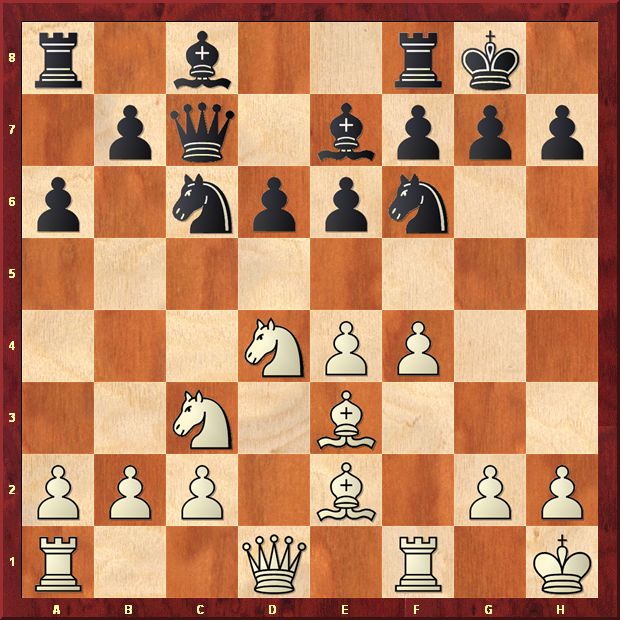
11.Qe1 (The queen will go to the square g3, creating attacking chances against the black king. After the positional approach 11.a4, I have originated the Twin Tower defense, 11...Re8 12.Bf3 Rb8, at the Manila Interzonal in 1976 against Yuri Balashov. It was later picked up by Garry Kasparov, who used it to win the last game of his 1985 match against Karpov and became the world champion. It is now the most popular defensive set-up.) 11...Nxd4 12.Bxd4 b5 13.a3 Bb7 14.Qg3 Rad8 (Black is at crossroads. Ftacnik's line was developed by Hungarian players in anticipation of white's attack on the kingside. Black can also try to play actively on the queenside with 14...Bc6 15.Rae1 Qb7 as in the other Areshchenko's game, which continued: 16.Bd3 b4 17.Nd1 bxa3 18.bxa3 g6 19.Nf2 Rac8 20.Qh3 Rfd8 21.Rb1 Qd7 22.Qh6 Bb5 23.Nh3 Bf8 24.Qh4 Nh5 25.g4 Be7 26.Ng5 e5? 27.gxh5 Bxg5 28.Qxg5 exd4 29.f5 Re8 30.f6 Kh8 31.hxg6 Re5 32.Qh6 [After 32...fxg6 33.f7 wins.] Black resigned in Areshchenko-Lammers, Bremen, Bundesliga 2010/11.) 15.Rae1 Rd7 16.Bd3 Re8 (Black is ready to fight.)
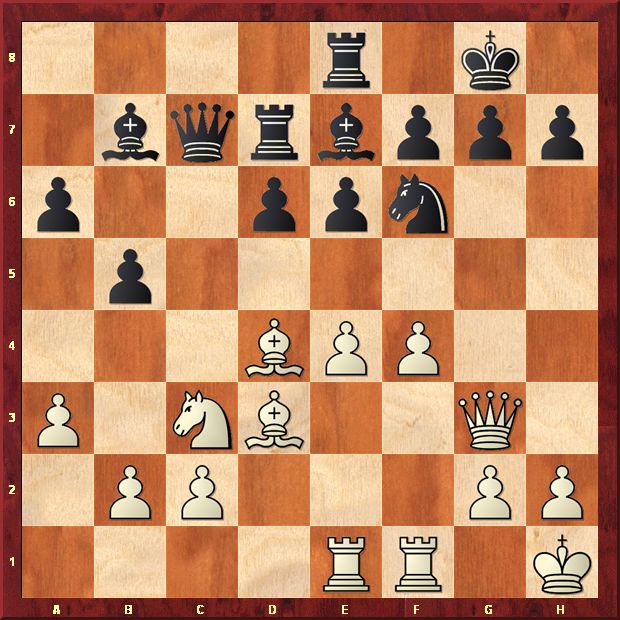
17.Re3!? (White would like to add more pieces to his attack. Swinging the knight to the kingside with Nc3-d1-f2 didn't bring much success and is being replaced by the rook-lift.) 17...g6 (Ftacnik tries to spare a move from the bunker strategy 17...Qd8 18.Qh3 g6 that showed some cracks after 19.Ref3!, preparing a powerful advance of the f-pawn. Black was unable to find a solid defense. For example:
A. 19...Bf8, white can sacrifice an exchange as in the game Azarov -Lamoureux, Budva 2009: 20.f5! exf5 21.exf5! g5 [After 21...Bxf3?! 22.fxg6 fxg6 23.Bxf6 Qxf6 24.Qxd7 white wins.] 22.Rg3 h6 23.Nd1 Be4 24.Ne3 d5 25.Bxf6 Qxf6 26.Ng4 Qh8 27.Qh5 Rd6 28.h4 Qh7 29.Rh3 Qg7 30.f6 Qh7 31.hxg5 d4 32.gxh6 Rde6 33.Qg5+ and black resigned.
B. The play through the center with 19...d5 is tackled by 20.f5!! dxe4 21.fxg6 fxg6 [After 21...exf3 22.Qxh7+! Nxh7 23.gxh7+ Kf8 24.h8R mates.] 22.Rxf6 Rxd4 23.Rf7 Bh4 24.Be2, threatening to win a piece with either 25.Rxb7 or 26.g3, as in the game Caruana -Sasikiran,Wijk aan Zee 2009.)
18.Ref3!? (Prepares the f4-f5 advance. The immediate 18.f5? is met by 18...e5 19.Nd5 [After 19.fxg6 fxg6 20.Nd5 Nxd5 21.exd5 Rf8 and black blunts the attack.] 19...Bxd5 20.exd5 exd4 21.fxg6 dxe3 22.gxf7+ Kxf7 23.Bxh7 Rh8 24.Qg6+ Kf8 25.Qh6+ Kf7 [Or 25...Ke8? 26.Bg6+ Kd8 27.Qxh8+ and white mates.] 26.Qg6+ and white has only a perpetual check.) 18...d5 (Preventing 19.f5, but allowing white to block the center.) 19.e5 Ne4 20.Qe1 b4 21.axb4 Bxb4 (Optically, black is not doing badly, but his kingside is still vulnerable.) 22.Rh3 Qd8 (Trying to prevent Qe1-h4, but 22...Bc5 23.Qh4 f5 was better.) 23.Qe3 (Not only escaping from the pin, but the queen may eventually end up on the square h6.)
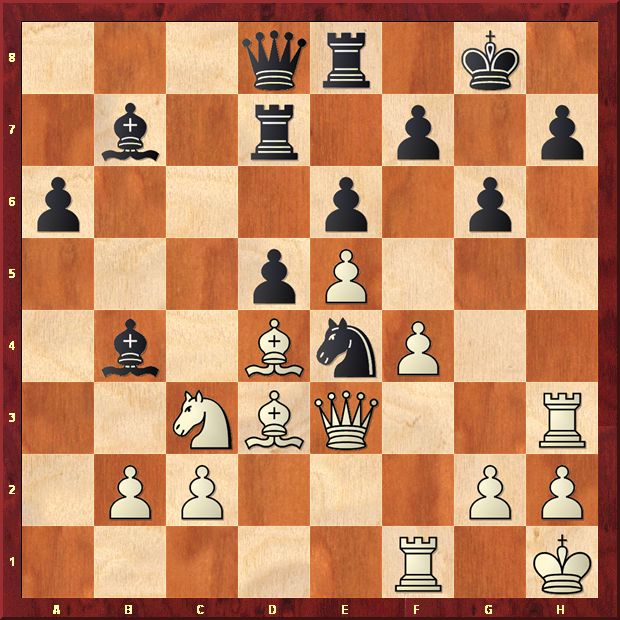
23...Nxc3? (Getting rid of the centrally-placed knight opens the door to a swift attack, but black may be uncomfortable facing the threat f4-f5. For example 23...Bc6 24.f5 Bxc3 25.Qh6 f6 26.bxc3 exf5 27.exf6 Rf7 28.g4 fxg4 29.Qxh7+!! Rxh7 30.f7+ Kf8 31.Rxh7 and white wins.) 24.bxc3 (White could play the fancy 24.f5!, but 24...Bf8 25.bxc3 transposes to the game. Keeping the piece 24...Ne4 loses after 25.Qh6 Ng5 [or 25...f6 26.exf6 Bf8 27.fxg6 Bxh6 28.f7+ Kf8 29.gxh7 Bg7 30.fxe8Q+ Kxe8 31.Bxg7 wins.] 26.f6 Bf8 27.Qxg5 Qc7 28.Rxh7 Kxh7 29.Rf3 Kg8 30.Rh3 Qa5 31.Qh4 wins.) 24...Bf8 (Black is almost out of hot water, but with the bishop on b7, white is able to break through on the light squares.)
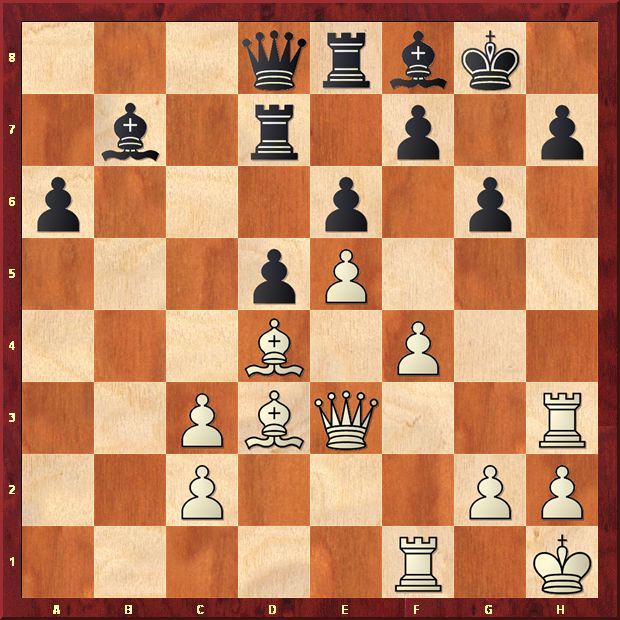
25.f5! (Black's position collapses. White's attack is too powerful.) 25...exf5 26.Bxf5! gxf5 (Black didn't have much choice. After 26...Rc7 27.e6 Bc8 28.Qg3! white has a decisive attack, for example 28...Bxe6 29.Bxg6 fxg6 30.Qxg6+ hxg6 [Or 30...Rg7 31.Rxf8+ Kxf8 32.Qxg7 mate.] 31.Rh8 mate.) 27.Rg3+ Kh8 28.e6+ f6 29.Rxf5 Bg7 30.Rh5! (Targeting the pawn on h7. Areshchenko probably felt that after 30.Rxg7!? Rxg7 [on 30...Kxg7 31.Qg5+ Kh8 32.Rxf6 Rg8 33.Rf8+ Rdg7 34.Bxg7 mates.] 31.Bxf6 Qxf6 32.Rxf6 d4 33.Qe5 dxc3 34.Rf7 Bxg2+ 35.Kg1 Reg8 winning could be more difficult.) 30...Rc7 31.Qd3 h6
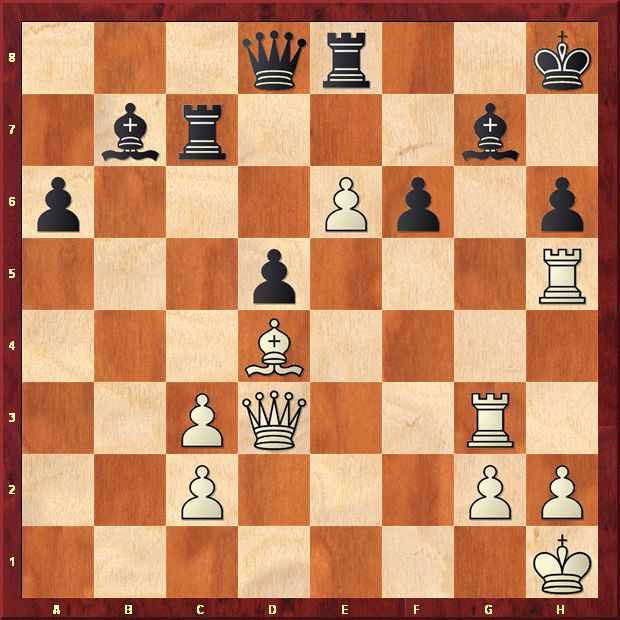
32.Rxg7! (Opening the floodgates. The white pieces sneak in.) 32...Rxg7 (After 32...Kxg7 33.Qg3+ white wins either after 33...Kf8 34.Rxh6 Rxe6 35.Rh8+ Ke7 36.Rh7+ Kf8 37.Bc5+!; or after 33...Kh7 34.Be3 Kh8 35.Bxh6 Rh7 36.Bg7+ Kg8 37.Bf8+ Kxf8 38.Rxh7.) 33.Rxh6+ Kg8 34.Qh3! (Threatening mate in one and black can't escape, for example 34...Rxe6 35.Qxe6+ Rf7 36.Bxf6 wins; or 34...Kf8 35.Bc5+ Ree7 36.Rh8+ Rg8 37.Qh6+ Ke8 38.Rxg8 mate.) Black resigned.
Note that in the replay windows below you can click on the notation to follow the game.
Image by Werder Bremen PR
No comments:
Post a Comment